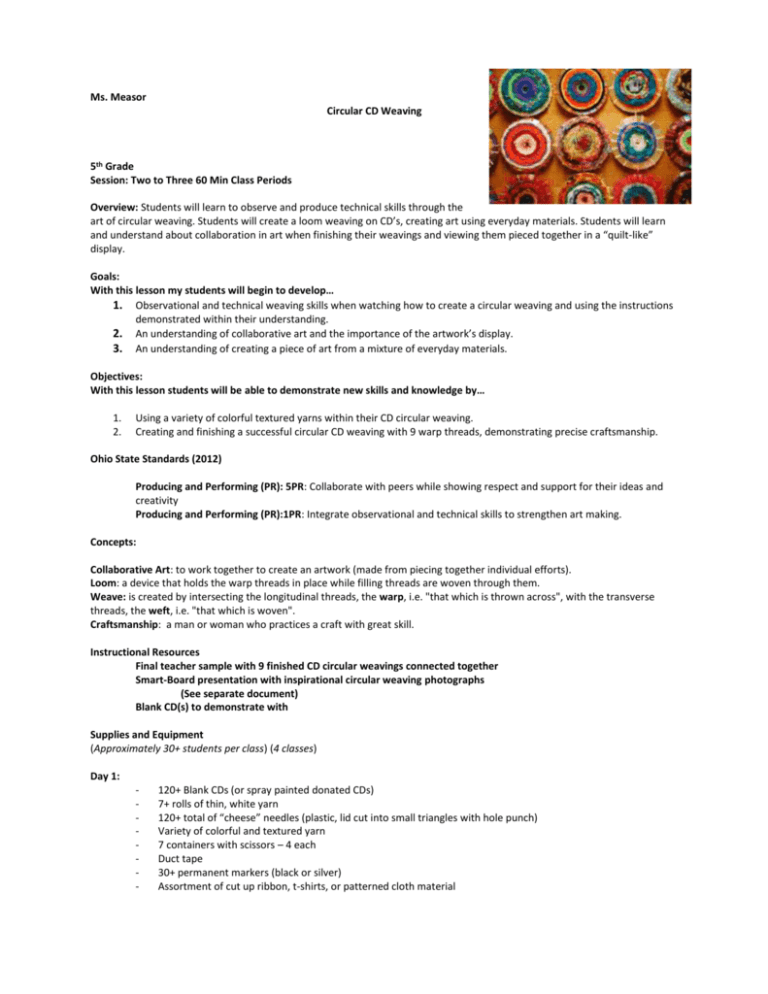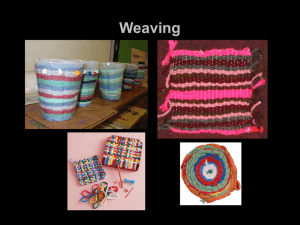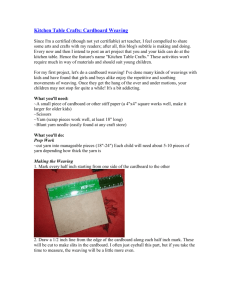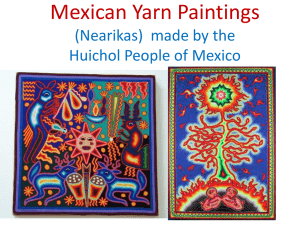File - Emily Measor
advertisement

Ms. Measor Circular CD Weaving 5th Grade Session: Two to Three 60 Min Class Periods Overview: Students will learn to observe and produce technical skills through the art of circular weaving. Students will create a loom weaving on CD’s, creating art using everyday materials. Students will learn and understand about collaboration in art when finishing their weavings and viewing them pieced together in a “quilt-like” display. Goals: With this lesson my students will begin to develop… 1. Observational and technical weaving skills when watching how to create a circular weaving and using the instructions demonstrated within their understanding. 2. An understanding of collaborative art and the importance of the artwork’s display. 3. An understanding of creating a piece of art from a mixture of everyday materials. Objectives: With this lesson students will be able to demonstrate new skills and knowledge by… 1. 2. Using a variety of colorful textured yarns within their CD circular weaving. Creating and finishing a successful circular CD weaving with 9 warp threads, demonstrating precise craftsmanship. Ohio State Standards (2012) Producing and Performing (PR): 5PR: Collaborate with peers while showing respect and support for their ideas and creativity Producing and Performing (PR):1PR: Integrate observational and technical skills to strengthen art making. Concepts: Collaborative Art: to work together to create an artwork (made from piecing together individual efforts). Loom: a device that holds the warp threads in place while filling threads are woven through them. Weave: is created by intersecting the longitudinal threads, the warp, i.e. "that which is thrown across", with the transverse threads, the weft, i.e. "that which is woven". Craftsmanship: a man or woman who practices a craft with great skill. Instructional Resources Final teacher sample with 9 finished CD circular weavings connected together Smart-Board presentation with inspirational circular weaving photographs (See separate document) Blank CD(s) to demonstrate with Supplies and Equipment (Approximately 30+ students per class) (4 classes) Day 1: - 120+ Blank CDs (or spray painted donated CDs) 7+ rolls of thin, white yarn 120+ total of “cheese” needles (plastic, lid cut into small triangles with hole punch) Variety of colorful and textured yarn 7 containers with scissors – 4 each Duct tape 30+ permanent markers (black or silver) Assortment of cut up ribbon, t-shirts, or patterned cloth material Day 2: - 120+ total of “cheese” needles (plastic, lid cut into small triangles with hole punch) Variety of colorful and textured yarn 7 packets of an assortment of colored permanent markers Assortment of cut up ribbon, t-shirts, or patterned cloth material Display purposes: Large amount of Twisty Ties / metal ties / thin pipe cleaners Thick yarn Scissors Accommodations Autistic: Students may not like the feel of certain materials. Allow them to choose what they are comfortable with. Student may be able to point to specific materials they are uncomfortable with. Teacher should then model techniques on how to accommodate to students needs by changing techniques or selecting a similar (but different) material. Announce transitions in advance or one on one. Teaching Procedures: Pre-Class Preparation Day 1: Collect 120+ CDs (whether bought or donated). Spray paint donated CDs to avoid distracting students from labels, etc. Collect and set aside 7+ balls of white, thin yarn. Collect thin, plastic lids and cut out 120+ “cheese” triangle needles and hole punch. Set out a large variety of yarn. Rip a large amount of small pieces of duct tape and set aside. Pass out containers to each table with scissors. 1-5: Greet students as they walk into the class room. Students will not need a painting shirt. - Begin the class period by displaying teacher sample. - Use teacher sample to reference and discuss how 1. Artists use every day materials to create interesting artwork and 2. Collaborative art. 5-10: Demonstrate how to create the loom by applying the warp of the weaving. Remember to o Create 9 warp threads. Very important and demonstrate what NOT to do (teacher sample with 8 warp threads). Demonstrate size of the white yarn with 2 “chest to yarn” lengths. o Start by threading one end of the white yarn through the middle hole of the CD and wrap the other end around the front and tie in the back. The backside can be the spray painted size or the “shiny” side. Duct tape down. o Hold in the middle of the CD and wrap. Once 9 warps are created wrap end of string through one “warp” and cut. Duct tape down. o Warps should not be loose. Duct tape all other warps in place on back of CDs 10-15: Give students time to create warps to their circular CD looms. - Pass out black permanent markers for blank, unused CDS. Pass out silver permanent markers to those students who have spray painted CDs. - Tell students to write their names and class codes on back. - Collect markers. 15-25: Demonstrate weaving techniques to students. o How to thread yarn through “cheese” needles. To tie or not to tie. o How to start weaving – remember to go “over and under” with the “weft” thread o Tight vs. loose yarn. o Thick vs. thin yarn (how to “double up”) o Length of yarn (not longer than 2 “chest to arm” lengths) o How to start and stop with yarn – the “tuck under” and remembering to follow the “over and under rule” o How to hold CD – Pinch and hold in the middle of the CD and wrap with the other. o Warn students about extreme, textured yarn. Be patient. o How to use cheese needles when reaching the last final threads of weaving. Students need to almost need to angle their needles and tuck underneath weaving to get through each warp. o If students want to use assortment of cut up ribbon, t-shirts, or patterned cloth material demonstrate how to use it with good craftsmanship. 25-55: Pass out different types of yarn to each table and switch over time. - If students want to request a specific color they need to patiently raise their hand or get started on another color. - If students want to use the cut up ribbon, t-shirts, or patterned cloth material they can chose from a variety of collected bins. - Attend to those students who need help. 55-60: Clean up. - Toss small bits of yarn in the trash. Each student needs to keep their “cheese” needle by tucking it underneath their yarn or warps on the back. - Collect weavings in separate box. - Place all yarn back into bins. - Dismiss students by stating the number in which they ranked for the day (1-15: 15 being the highest based on behavior) Pre-Class Preparation Day 2: Organize and set aside yarn. Present Smart-Board presentation on first slide. Have CD’s from Day 1 ready to pass out. 1-10: Greet students as they walk in. Present teacher sample. - Ask students to look towards the smart-Board for a short presentation. - Show students pictures (see on separate document) of inspirations towards color, pattern, and craftsmanship when making their weavings. 10-15: Quickly demonstrate to students how to handle specific different ribbons, and other materials besides yarn. - Remind students how to stop and start color. - Quickly remind students how to use “cheese” needles when reaching the final stages of CD weaving. 15-55: Pass out CD’s from Day 1. Pass out scissors. - Help pass out yarn and make available to students. - Assist anyone who needs extra help. - Play music. - Remind students as time goes by how “far along” they should be, according amount of time they have had to work. 55-60: Students should wrap up their needles and yarn for the third day. Keep needles. - Clean up. - Collect all CD’s. - Place all yarn back into bins. - Dismiss students by stating the number in which they ranked for the day (1-15: 15 being the highest based on behavior) Day 3: Set aside permanent marker packets with assortment of colors (7 packets). Organize and set out yarn. Set aside student projects. 1-10: Greet students as they walk into the classroom. - Explain to students that they should be finished with their CD weavings today. - Quickly demonstrate how to create designs and patterns using their permanent, colored markers on the CD if they have extra space or choose to do so because it would have an interesting effect. - Make sure students do not smudge permanent markers or attempt to fill in the entire “shiny” space because of smudges. 10-55: Pass out CD’s. Pass out scissors. Pass out markers. - If students are far along and feel they can finish another CD in given time, allow them to make a second. - Help pass out yarn and make available to students. - Assist anyone who needs extra help. - Play music. - Remind students as time goes by how “far along” they should be, according to the amount of time they have had to work. - Students should finish their weavings at the end of Day 3. 55-60: Clean up. - Collect all CD’s and cheese needles. Collect markers. - Place all yarn back into bins. - Dismiss students by stating the number in which they ranked for the day (1-15: 15 being the highest based on behavior) Teacher Sample: 5th Grade Using different materials Craftsmanship Following Instructions when applying warp and weft threads








